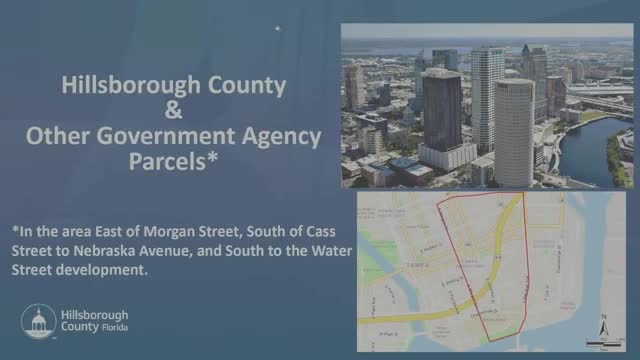Hillsborough commissioners direct staff to update courts master plan, explore funding for new criminal courthouse
October 02, 2025 | Hillsborough County, Florida
This article was created by AI summarizing key points discussed. AI makes mistakes, so for full details and context, please refer to the video of the full meeting. Please report any errors so we can fix them. Report an error »

Hillsborough County commissioners on Oct. 1 unanimously authorized county staff to participate in a courts‑led stakeholder committee to update the 2020 courts master plan and directed staff to investigate additional non‑ad valorem funding sources for a proposed new criminal courthouse. The two motions passed 7‑0.
The motions followed a staff briefing on county‑owned land in the immediate County Center area and comments from stakeholders including the local judiciary and prosecuting and defense offices. Commissioner Perry Cohen said the county has “had a demonstrated need for some time for a new criminal courthouse,” and urged planning for a long‑term project.
The board approved two separate actions: first, to authorize staff to work with a committee led by the courts to revise the 2020 scope, budget and building strategies and return recommended options to the board; second, to authorize county staff to explore non‑ad valorem funding sources that could supplement the $155,000,000 already proposed in the county’s Capital Improvement plan (referred to in the meeting as the CIT). Commissioner Cohen moved both actions; the first motion was seconded by Commissioner Wolstol and the second was seconded by Commissioner Myers. Both carried 7‑0.
John Mueller, director of Facilities Management Real Estate Services, presented the board with an inventory of county property in the downtown area and told commissioners the study covered about 19 parcels totaling roughly 28.6 acres near the County Center. Mueller also noted adjacent public agency holdings and that portions of the expressway right‑of‑way in the area might be considered for mixed‑use mobility hubs, a factor some stakeholders said could affect long‑term planning.
Commissioners discussed alternatives including siting records facilities outside the downtown core. Commissioner Christine Miller asked that East County options be included in planning, noting growth in that area and that the clerk’s office has identified separate records needs. Cohen asked staff to consider a broad range of finance approaches, naming public‑private partnerships and debt instruments, and to evaluate federal and state funding opportunities.
The motions do not authorize design or construction spending; they direct staff to participate in planning and to return funding options and recommendations to the board for future decisions.
The motions followed a staff briefing on county‑owned land in the immediate County Center area and comments from stakeholders including the local judiciary and prosecuting and defense offices. Commissioner Perry Cohen said the county has “had a demonstrated need for some time for a new criminal courthouse,” and urged planning for a long‑term project.
The board approved two separate actions: first, to authorize staff to work with a committee led by the courts to revise the 2020 scope, budget and building strategies and return recommended options to the board; second, to authorize county staff to explore non‑ad valorem funding sources that could supplement the $155,000,000 already proposed in the county’s Capital Improvement plan (referred to in the meeting as the CIT). Commissioner Cohen moved both actions; the first motion was seconded by Commissioner Wolstol and the second was seconded by Commissioner Myers. Both carried 7‑0.
John Mueller, director of Facilities Management Real Estate Services, presented the board with an inventory of county property in the downtown area and told commissioners the study covered about 19 parcels totaling roughly 28.6 acres near the County Center. Mueller also noted adjacent public agency holdings and that portions of the expressway right‑of‑way in the area might be considered for mixed‑use mobility hubs, a factor some stakeholders said could affect long‑term planning.
Commissioners discussed alternatives including siting records facilities outside the downtown core. Commissioner Christine Miller asked that East County options be included in planning, noting growth in that area and that the clerk’s office has identified separate records needs. Cohen asked staff to consider a broad range of finance approaches, naming public‑private partnerships and debt instruments, and to evaluate federal and state funding opportunities.
The motions do not authorize design or construction spending; they direct staff to participate in planning and to return funding options and recommendations to the board for future decisions.
View full meeting
This article is based on a recent meeting—watch the full video and explore the complete transcript for deeper insights into the discussion.
View full meeting